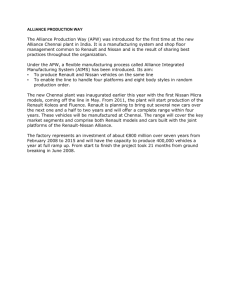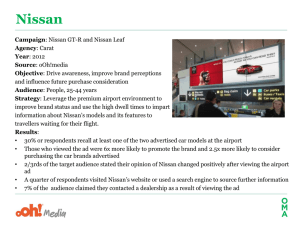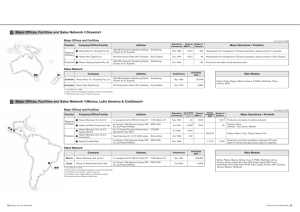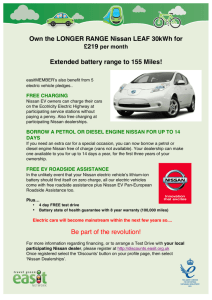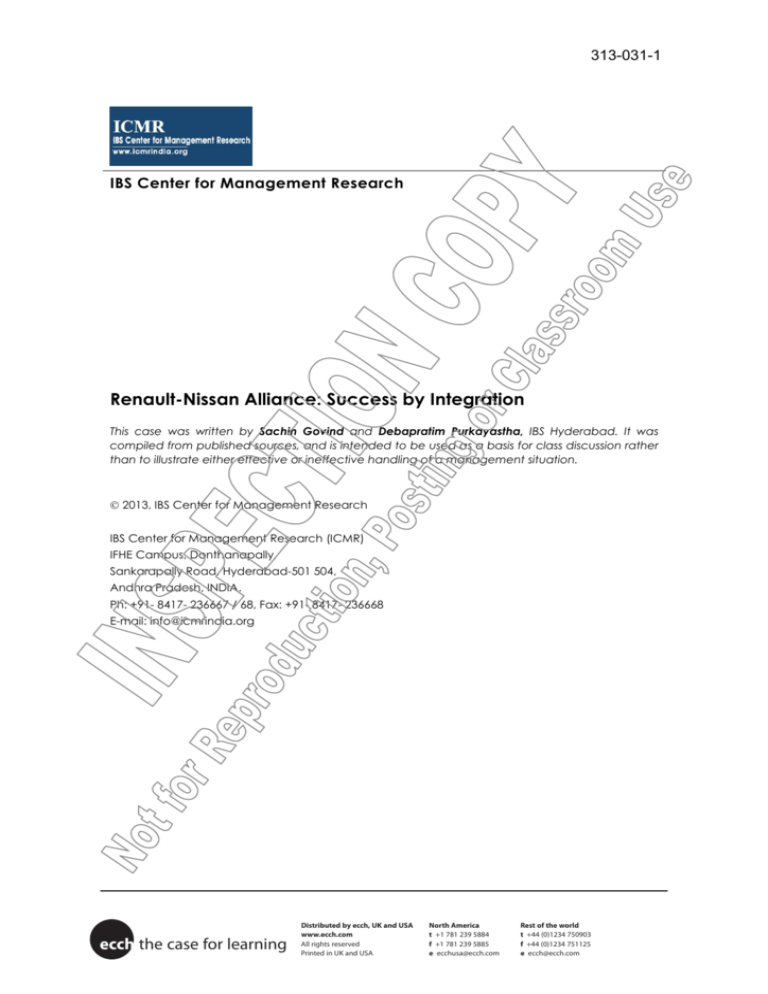
313-031-1
IBS Center for Management Research
Renault-Nissan Alliance: Success by Integration
This case was written by Sachin Govind and Debapratim Purkayastha, IBS Hyderabad. It was
compiled from published sources, and is intended to be used as a basis for class discussion rather
than to illustrate either effective or ineffective handling of a management situation.
© 2013, IBS Center for Management Research
IBS Center for Management Research (ICMR)
IFHE Campus, Donthanapally,
Sankarapally Road, Hyderabad-501 504,
Andhra Pradesh, INDIA.
Ph: +91- 8417- 236667 / 68, Fax: +91- 8417- 236668
E-mail: info@icmrindia.org
ecch the case for learning
Distributed by ecch, UK and USA
www.ecch.com
All rights reserved
Printed in UK and USA
North America
t +1 781 239 5884
f +1 781 239 5885
e ecchusa@ecch.com
Rest of the world
t +44 (0)1234 750903
f +44 (0)1234 751125
e ecch@ecch.com
313-031-1
Renault-Nissan Alliance: Success by Integration
“We are proud of all we have achieved in the past 10 years and we are looking forward to
realising even more of our potential in the future. Leveraging our partnership fully in the Alliance,
we will be taking further steps to deepen synergies between Renault and Nissan that will
contribute to the profitable growth of each company.”1
– Carlos Ghosn, president and chief executive officer of Renault and Nissan.
DIFFERENT BUT SAME
In the first week of September 2012, Renault India, the subsidiary of French automaker Renault
SA (Renault), launched the Scala, a mid-size sedan, in the Indian market. While the car’s styling
and features were appreciated, most reviewers pointed out that the Scala was nothing but a
rebadged Sunny2, a sedan launched by Nissan Motor India Pvt. Ltd., the subsidiary of Nissan
Motor Company Ltd. (Nissan), in India in September 2011.
Renault India had earlier launched the Pulse, a hatchback, in the Indian market3. The Pulse was a
rebadged Micra, launched by Nissan India in mid-20104 (Refer to Exhibit I(A) for images of
Nissan Sunny and Renault Scala and to Exhibit I(B) for Nissan Micra and Renault Pulse).
The Renault-Nissan Alliance, established in 1999, was a unique arrangement in the automotive
world. While mergers and acquisitions were common, a long-term, multi-faceted alliance between
two culturally disparate entities was path-breaking. The Alliance involved cross holding, joint
development, and joint production, and sharing best practices, platforms, parts and components,
powertrains, and plants. The Alliance enabled Renault and Nissan to reduce costs and time to
market, increase competitiveness, and improve profitability. The Renault-Nissan Alliance was
often cited as a lesson in strategic alliance and integration.
However, the Alliance faced some tough challenges. In 2011-12, Renault’s market share in Europe
saw a slide. Also, with the tenure of Carlos Ghosn, the CEO of Nissan and Renault, expected to
end in 2014, there were serious concerns about the future prospects of the Alliance as it seemed
unlikely that a single person would be appointed as the CEO of the two auto companies again.
ABOUT NISSAN
Nissan’s origins date back to 1911, when Masujiro Hashimoto set up The Kwaishinsha Motor Car
Works in Japan. After assuming different forms, the company was rechristened Nissan Motor Co.
Ltd., when Nihon Sangyo Co. Ltd. acquired a 100% stake in June 1934.
Nissan’s first factory was based in Yokohama city, Kanagawa Prefecture. The first automobile
models, called “Datsun,” were launched in the early 1930s. In 1937, Nissan introduced the Model
70, a passenger car model; the Model 80, a truck; and the Model 90, a bus.
During the Second World War, Nissan was forced to stop production of passenger cars and trucks.
Production resumed in 1945, when the first post-war car rolled off the production line. The late
1940s witnessed the launch of several new models, such as the Model DA, Model DB, Model 290,
etc.
2
313-031-1
In 1952, Nissan entered into a technological cooperation agreement with UK-based Austin Motor
Co. Ltd. In 1959, the company established its first overseas factory in Taiwan.
In 1960, Nissan set up base in the US. The following year, Nissan Mexicana, SA de CV was
established in Mexico. In the 1960s, several new models such as the Datsun Bluebird, Gloria,
Silvia, President, Laurel, Skyline, Cedric, Echo, Sunny, etc., were launched. In 1969, cumulative
exports touched the 1 million mark.
In 1972, the cumulative domestic production of vehicles breached the 10 million mark. And by
1977, cumulative production had surpassed 20 million units.5 In 1979, the Nissan Design
International, Inc. was established in the US. During this period, Nissan launched models such as
the Cabstar, Civilian, Cherry FII, and Caravan.
In 1981, Nissan started marketing its vehicles under the Nissan marquee as part of a new corporate
identity program. In 1986, the company announced its new corporate principles and philosophy. In
1989, Nissan Europe NV, Nissan’s regional headquarters for European operations, and Nissan
Distribution Service (Europe) BV were established in the Netherlands.
In October 1992, cumulative domestic sales surpassed 30 million units.6
As of FY 2011, Nissan employed 157,365 employees and recorded a net profit of ¥341,433
million.7 (Refer to Exhibit II for financial information on Nissan)
ABOUT RENAULT
Renault’s origins can be traced to 1898, when Louis Renault started to build the “voiturette,” a
two-seater vehicle. Louis’ factory increased its output from six vehicles in 1898 to 4,200 in 1913.8
The First World War had a negative impact on France’s economy. However, after the War ended,
Renault resumed automobile production. Renault diversified into other areas such as locomotives,
tractors, and aircraft. In the 1930s, the company continued to manufacture affordable and
appealing automobiles.
In 1940, France was occupied by Nazi forces. Renault’s factories came under German control. In
order to provide work for its staff, Renault agreed to manufacture and repair tanks, vans, and
coaches.
In the mid-1940s, Renault became a national corporation and focused on building commercial
vehicles in order to contribute to the rebuilding of the French economy. In this period, Renault
launched the 4CV, which went on to become one of the best-selling models of the company.
By the mid-1950s, Renault had become one of France’s leading companies. In this period, the
company launched several iconic models such as the Renault 4, Renault 8, Renault 12, Renault 16,
and Alpine A 110.
In the mid-1970s, Renault launched the Renault 5, a fuel-efficient car model that became a bestseller. In 1977, Renault entered the world of Formula 1 racing. It recorded 15 Grand Prix wins
between 1979 and 1983. However, the company’s financial position deteriorated during this
period. In 1984, it implemented a revival plan, which involved resizing and changing focus.
The period between the late 1980s and the early 1990s saw the company returning to profitability.
Renault introduced the concept of “total quality” in this period.
In the mid-1990s, Renault was privatized; however, the government remained a shareholder. In the
late 1990s, Renault models such as the Twingo and the Megane were very popular.
In 2000, Renault acquired Daciaa, a Romania-based automaker, and Korea-based Samsung Motors.
a
Founded in 1966 as Uzina de Autoturisme Pitesti, Automobile Dacia was acquired by Renault with the
aim of making Romania the manufacturing hub for Eastern Europe.
3
313-031-1
In 2004, Renault launched the Logan, an entry-level sedan developed for emerging markets. This
model allowed the company to expand its presence outside Europe.
In FY 2011, the Renault group recorded €42,628 million in sales and €2.1 billion in net income.
(Refer to Exhibit III for financial information on Renault)
THE RENAULT-NISSAN ALLIANCE
In the mid- to late 1990s, several auto companies either acquired other auto companies or entered
into joint ventures with them. This was done for several reasons such as to enter new markets,
quicken the rate of expansion, reduce costs, or acquire technology. For instance, in 1998, Daimler
Benz, a major German auto maker, acquired Chrysler, a US-based auto company.9 Similarly, PSA
Peugeot Citroen, a French auto maker, entered into an alliance with Ford, the US-based auto
company.10 The Renault-Nissan Alliance came about when Nissan was in a bad shape financially.
In the mid-1990s, Nissan incurred huge losses and was in debt. The automaker’s market share in
Japan had been 34% in 1974; but by 1999, it had fallen to less than 19%11. Its world-wide market
share too had shrunk from 6.6% in 1990 to 4.9% in 1999.12 In the year 1999, Nissan recorded a net
operating loss of ¥684 billion.13 Also, its plant utilization rate was only 53%.14 For Renault, the
Alliance was a way to learn the famed Japanese manufacturing systems.15 The company expected
Nissan to help it to improve its productivity and manufacturing capabilities.
In March 1999, Louis Schweitzer, then CEO of Renault, and Yoshikazu Hanawa, CEO of Nissan,
signed an agreement to establish a unique alliance, which involved Renault acquiring 36.8% of
Nissan’s shares for $5.4 billion.16 Nissan later acquired 15% share in Renault but without voting
rights.17 The alliance was called the Renault-Nissan Alliance or just Alliance (Refer to Exhibit IV
for the Renault-Nissan Alliance logo).
Carlos Ghosn (Ghosn), who joined Renault in 1996 as executive vice president, was made chief
operating officer (COO) of Nissan in June 1999. Ghosn said, “In the 1990s, Nissan was a company
on life support with $20 billion in debt. Renault decided to form an alliance, not a merger. We
created something unique in the auto industry and in industry overall.”18
NISSAN REVIVAL PLAN
In June 2000, Ghosn was made President of Nissan and later in June 2001, he was appointed CEO
as well. Ghosn had launched the Nissan Revival Plan (NRP), a set of reforms that was expected to
rescue the debt-ridden company and bring it back to profitability, in October 1999. The
implementation of the NRP began in April, 2000. The plan involved slashing jobs, closing down
factories, reducing the number of vehicle platforms, dismantling the Keiretsu networkb, investing
in new technology, and setting up an efficient production system. The NRP had three primary
objectives –
•
Return to net profitability in fiscal year 2000
•
Achieve a minimum operating income to sales margin of 4.5% by fiscal 2002
•
Reduce consolidated debt to less than ¥700 billion by fiscal 2002.19
Nissan was able to meet all the goals of the revival plan. By 2002, the company had increased its
plant utilization rate to 75% from around the 50% it had recorded before the plan was
implemented, reduced the number of suppliers, revamped the sales and distribution system, and
sold off non-core assets. Earlier, purchasing costs accounted for 60% of Nissan’s overall costs. By
b
Keiretsu refers to a system of complicated business grouping in Japan. Each enterprise in a keiretsu owns
small shares in other companies in the group. This system allowed Japanese companies to insulate
themselves from market fluctuations and hostile takeovers.
4
313-031-1
centralizing the purchasing function and slashing the number of suppliers from 6,900 in 1999 to
not more than 3,400 in 2002, Nissan was able to cut its purchasing costs by 20%. “This
performance was made possible because the execution of the NRP was swift, relentless, and
without compromise,”20 said Ghosn. (Refer to Exhibit V for Nissan’s financials in FY1999 and
FY 2003).
A LESSON IN INTEGRATION
The Renault-Nissan Alliance was established with the aim of developing synergies while keeping
the identities of the Nissan and Renault brands intact and preserving the corporate culture of the
two entities.
The partnership was based on trust and mutual respect. “You can make companies work together
even if they are on different continents. One company does not need to take over the other, nor is it
crucial for both companies’ cultures to meld into one. Preserving distinct styles helps each
company’s employees identify with their employer and stay motivated,”21 said Ghosn.
The primary objective of the Alliance was to pursue a strategy of profitable growth. The Alliance
aimed to be regarded among the top three automobile companies in terms of:
1. Quality and value
2. Technology, especially in electronics, engines, and eco-friendly technologies
3. Profitability
STRUCTURE OF THE ALLIANCE
The capital structure of Renault and Nissan, with Renault holding 43.4% (as of 2012) in Nissan
and Nissan holding 15% of Renault22, was seen as one of the reasons for the success of the
alliance. “This structure has been very solid to help us cement the alliance, create a strong sense of
belonging to the alliance, even though people are still fiercely Renault or fiercely Nissan,”23 said
Ghosn.
The Alliance was managed by Renault-Nissan BV, founded on March 28, 2002, in The
Netherlands. Renault-Nissan BV, owned equally by Renault and Nissan, was established under
Dutch law, and was the registered office of the Alliance Board, which met in Tokyo and Paris.
RENAULT-NISSAN PURCHASING ORGANIZATION
In 2001, the Alliance established the Renault-Nissan Purchasing Organization (RNPO), which was
to make joint purchases for Renault and Nissan. While initially, only 30% of the companies’
purchases were dealt with by RNPO, from April 1, 2009, the organization accounted for 100% of
the companies’ purchases.24
RENAULT-NISSAN INFORMATION SERVICES
To optimize the information systems of the two companies, the Alliance set up the Renault-Nissan
Information Services.
ALLIANCE BOARD
The Alliance Board was made up of executives from both Renault and Nissan. The Board
validated Nissan’s and Renault’s business plans, encouraged development of synergies, and
monitored the Alliance’s progress.
ALLIANCE INTEGRATED MANUFACTURING SYSTEM
In addition to the two jointly owned companies, the Alliance established several joint systems such
as the Alliance Integrated Manufacturing System (AIMS) to improve efficiency and reduce
duplication of effort. The AIMS was first used at the Renault-Nissan plants in Chennai in India,
and Tangiers in Morocco. The new Renault Nissan Automotive India Pvt. Ltd. (RNAIPL) plant in
5
313-031-1
Chennai was able to start production in record time mainly because of AIMS. “This is the shortest
term in construction – the plant was commissioned in 21 months from land levelling. We did best
benchmarking not only in the Alliance but also in India,”25 said Akira Sakurai, CEO and Managing
Director of RNAIPL. The AIMS provided flexibility in the vehicle assembly line, allowing for the
manufacture of four different platforms in eight shapes and on random production schedules.
AIMS also reduced the space required for each platform, optimizing efficiency.
DEDICATED TEAMS
In 2009, Renault-Nissan BV hired a dedicated team of professionals to increase synergies between
Renault and Nissan. This team reported to the Alliance Board. The team consisted of 16 members
– 11 Alliance Managing Directors and 5 Alliance Directors.26 The Managing Director of a global
Alliance function was responsible for managing the function across the Alliance.
The Alliance Directors didn’t manage functions, but made sure stronger synergies were developed.
Alliance Directors could oppose any measure taken by Renault or Nissan that went against the
development of synergies, taking the matter to the executive committee of the company concerned
or even, ultimately, the Alliance Board.
Priority areas of the dedicated team included purchasing, industrial sourcing, common platforms
and parts, powertrains, global logistics, IS/IT, research, advanced zero emission business, and
support and cooperation with Daimler AZc.
The Alliance Quality Charter defined quality procedures and established joint tools. In addition,
the Alliance set up Steering Committees, which managed common programs and guided the
synergy hunting activities. The Cross-Company Teams (CTT) checked the implementation made
by line organization. The Functional Task Team (FTT) supported the daily work of the Alliance
bodies. For instance, the Quality Functional Task Team studied the most efficient quality practices
of both Renault and Nissan and harmonized practices and tools. Task Teams helped Steering
Committees with specific tasks.
BENEFITS OF THE ALLIANCE
The Alliance provided several benefits to the two companies.
SHARING SYSTEMS AND BEST PRACTICES
After the Alliance was established, Renault developed a common production standard to be used
by all Renault plants. This manufacturing system, called the Renault Production System, was
based on the Nissan Production Way (Refer to Table I for the Nissan Production Way).
Between 1998, when the system was set up, and 2009, Renault was able to increase its
productivity by 15%.27
Once a year, 30 teams, consisting of Renault and Nissan employees drawn from different regions
and functions, identified best practices and synergies that the Alliance partners could share.
Table I
The Nissan Production Way
The Nissan Production Way was a production system introduced by Nissan in 1994. This
system had three main aims: efficient global production, waste elimination, and improvement of
plant competitiveness.
Contd…
c
Daimler AG (formerly Daimler-Chrysler) is a multinational automobile corporation, with its headquarters
in Stuttgart, Germany.
6
313-031-1
Contd…
Efficient global production was achieved by incorporating flexibility, which enabled reduction
in investment required to start a factory, improve the ease of setting up production facilities, and
achieve optimum utilization ratio.
Waste minimization was achieved by Doukie–Seisan or synchronized production, which
allowed minimizing inventory and improving equipment efficiency and logistics efficiency.
Improvement of plant competitiveness was achieved by benchmarking. Plants spread across the
world were encouraged to compete against each other. At the same time, efforts were made to
encourage information sharing through the intranet.
The Nissan Production Way involved several initiatives. Here are a few:
4G Strategies: This involved setting up of 4 centers – the Global Training Center (GTC), the
Global Production Engineering Center, the Global Launching Expert, and the Global Package
Design Center. For example, the GTC had Global Master Trainers, who would improve
employee skills and communicate the right way of doing things. Similarly, the GLE diagnosed
preparation status and provided initial quality control support.
Source: www.nissan-global.com.
SHARING TECHNOLOGIES
In order to save costs and improve competitiveness, Renault and Nissan focused on different
technologies and then incorporated these technologies in Nissan and Renault models. For example,
Nissan focused on gasoline engine development while Renault’s area of focus was diesel engine
technology. Similarly, both partners contributed equally to new product development. For
instance, Nissan provided several inputs for the development of Renault group’s first cross-over,
Renault Koleos, which was manufactured by Renault Samsung Motors in Korea.
SHARING PARTS
The Alliance also co-developed common engines such as the V6 diesel engine and gearboxes such
as the six-speed manual gearbox. These were used in both Nissan and Renault models. For
instance, the Nissan 3.5 liter gasoline was used for the Renault Laguna and the Renault 1.5 liter
diesel engine was used for the Nissan Qashqai. (Refer to Exhibit VI for details on
part/component sharing between Renault and Nissan).
SHARING PLATFORMS
In order to reduce development costs and benefit from economies of scale, the Alliance partners
shared platforms and parts that were not visible to the customer. For instance, the ‘B’ platform was
used by Renault for the Clio and by Nissan for the Tiida and the Versa. Similarly, the ‘C’ platform
was used by Renault for the Megane and Scenic and by Nissan for the Qashqai. These auto models
accounted for more than 50% of the Alliance’s worldwide sales.
SHARING PLANTS
Within the Alliance, each company used the manufacturing capacities of the other. For instance,
Renault’s plants manufactured Nissan models in Korea (Almera Classic) and Brazil (Livina), and
Nissan assembled Renault models in Mexico (Clio), South Africa (Sandero), and Spain (Trafic).
The Alliance helped expand Renault’s and Nissan’s product portfolios. Nissan was able to expand
its Light Commercial Vehicle range in Europe by rebadging Renault products such as Renault
Kangoo (Nissan Kubistar), Renault Master (Nissan Interstar), and Renault Trafic (Nissan
Primastar).
7
313-031-1
GROWING THROUGH COLLABORATION
The Renault-Nissan Alliance was widely regarded as a success. The unique arrangement allowed
the partners to take advantage of synergies, while maintaining separate identities and branding.
“From the beginning, the Alliance has been based on the premise of trust and the pursuit of
strategies aimed at profitable growth,”28 said Ghosn.
Traditionally, Nissan had been strong in the US and Japan while Renault’s performance had been
better in Russia, France, and Brazil. However, as sales growth in developed countries was
expected to be low in the coming years, both Renault and Nissan announced their intention to
strengthen their market shares in emerging markets such as China, India, and Brazil. The two auto
companies were to carry out joint development, R&D, and production in emerging markets, just as
they did in developed markets (Refer to Exhibit VII (A), VII (B), VII (C) for the top markets of
the Alliance, Renault, and Nissan respectively).
In late 2007, Carlos Ghosn had announced the Alliance’s goal to produce affordable zero-emission
electric vehicles and become a leader in that market. Over the next few years, Renault and Nissan
spent billions of dollars in research, engineering, and production of electric vehicles. The Alliance
helped minimize the expenditure to a large extent as the partners standardized the components that
they would use in the zero-emission vehicles. In 2010, Renault and Nissan showcased several
zero-emission electric vehicles at different auto shows. In 2011, Renault launched the Kangoo
Z.E., Fluence Z.E., Zoe, and Twizy. These models were manufactured in Renault plants in France,
Turkey, and Spain. Nissan launched the Leaf in North America, Europe, and Asia.
In 2010, the Renault-Nissan Alliance became a three-way partnership with Daimler AG, the
German auto major, joining in. The alliance was to focus on sharing resources in four main areas:
platforms for small cars and light commercial vehicles; small petrol and diesel engines; technology
for fully electric and hybrid cars; and bigger diesel engines. After the partnership was announced,
Ghosn said, “The Renault-Nissan Alliance knows how to work successfully in collaborative
partnerships.”29
CHALLENGES AHEAD
Though Renault and Nissan had improved efficiency and reduced costs over the years, the two
companies had as of 2012 yet to match the efficiencies of Toyota Motor Corporationd or the
Volkswagen Groupe, which were both centrally managed and closely integrated.30
Despite the cost advantages, technology sharing, and synergies with Nissan, Renault’s market
share in Europe had shrunk in 2011. On the other hand, the VW Group was consolidating its
position as the number one player in Europe (Refer to Exhibit VIII for market shares of top
auto makers in Europe).
Also, the success of the Alliance seemed to have inspired other auto makers to emulate Renault
and Nissan. For instance, VW acquired a 20% stake in Japan-based Suzuki Motor Corporationf.
Similarly, Fiat acquired a 20% stake in US-based Chrysler. Though it remained to be seen if these
alliances would succeed, the Renault-Nissan Alliance had much to worry about if rival auto
makers, too, improved their competitiveness through strategic alliances.
d
e
f
Japan-based Toyota Motor Corporation is the second largest automobile company in the world by
production.
Volkswagen Group consists of the parent company, Volkswagen Akteingesellschaft, based in Wolfsburg,
Germany, and subsidiaries Audi AG, Automobili Lamborghini S.p.A, Bentley Motors Ltd., Bugatti
Automobiles S.A.S, Ducati Motor Holding SpA, Man SE, Porsche AG, Scania AB, SEAT SA, and Skoda
Automobiliva AS.
Suzuki Motor Corporation is Japan’s fourth largest automobile company after Toyota, Nissan, and
Honda. The company also manufactures 4x4 vehicles, all-terrain vehicles, full range of two-wheelers,
outboard marine engines, wheelchairs, etc.
8
313-031-1
According to Moody’sg, the global auto industry in 2013 would see reduced demand growth.
“…we have revised our forecast for 2013 demand growth to 2.9% from our January forecast of
4.5%,”31 said Falk Frey, a Senior Vice President in Moody’s Corporate Finance Group. The
demand for cars was expected to fall in Europe by 3% and shrink in several other markets. This
was expected to pose a challenge to the Alliance.
The Alliance was also expected to face internal challenges in 2014. Prior to Renault’s partial
acquisition of Nissan, Nissan’s organization culture had been closed-minded. As part of the NRP,
efforts were made to correct this by hiring employees with diverse backgrounds and from different
regions. “In 1999, Nissan was homogeneous and closed-minded. Nearly all of the senior managers
were from a single country, and most had graduated from the same few universities. Today, nearly
half of Nissan’s senior executive team was born outside Nissan’s home country — a greater
percentage than probably any other big company in Japan and in our industry,”32 Ghosn said in
early 2012. However, according to analysts, working together with two disparate cultures would be
tough when the two companies ceased to have a common CEO. According to analysts, the
Renault-Nissan Alliance’s success had a lot to do with Ghosn being the CEO of both Renault and
Nissan. Ghosn enjoyed credibility within both companies. With Ghosn expecting to step down
from the post of CEO of Renault and Nissan in 2014, it was not certain if the operation of the
Alliance would continue to be a smooth affair.
g
Moody’s provides credit ratings, research, tools, and analysis.
9
313-031-1
Exhibit I (A)
Nissan Versa/Sunny and Renault Scala
Source: http://cars.about.com and http://zigwheels.com
Exhibit I (B)
Nissan Micra and Renault Pulse
Source: www.cardekho.com
Source: www.renault.com.
10
313-031-1
Exhibit II
Financial Information on Nissan
2007
2008
2009
2010
2011
Net Sales in
billion ¥
10,824
8,437
7,517
8,773
9,409
Operating
Margin in
billion ¥
791
-138
312
538
546
Net income
in billion ¥
482
-234
42
319
341
Source: www.nissan-global.com.
Exhibit III
Financial Information on Renault Group
2007
2008
2009
2010
2011
Revenues in
billion €
40.6
37.8
33.7
39.0
42.6
Operating
Margin in
billion €
1.3
0.3
-0.4
1.1
1.1
Net income
in billion €
2.6
0.6
-3.1
3.5
2.1
Source: www.renault.com.
Exhibit IV
The Alliance Logo
Source: www.nissan-global.com
11
313-031-1
Exhibit V
Nissan’s Financials in 1999 and 2003
FY 1999
FY 2003
5,977.1
7429.2
Operating Income (in billion yen)
82.6
829.4
Operating Margin
1.4%
11.2%
Net Income (in billion yen)
(684.4)
503.7
Total Net Debt (in billion yen)
1348.7
13.6
Total Assets (in billion yen)
6541.2
7859.9
Net Sales (in billion yen)
Source: Nissan’s Annual Reports
Exhibit VI
Component Sharing between Renault and Nissan
Engine/gearbox
Car Models
4 cylinder 1.6 liter gasoline engine
Nissan: Micra, Cube, Tiida,
Wingroad, Expert, Livina, NV200
4 cylinder 2.0 liter gasoline engine
Renault Clio, Megane/Scenic, Laguna
4 cylinder 2.0 liter diesel engine
Renault: Megane/Scenic, Laguna, Espace, Vel
Satis, Trafic, Nissan: Qashqai, X-Trail, Primastar
6 cylinder 3.0 liter diesel engine
Renault Laguna
6-speed manual transmission
Renault: Modus, Clio, Megane, Laguna
Source: Nissan Annual Report
12
Versa,
Note,
313-031-1
Exhibit VII
Market Shares of Auto Makers in Europe
Market Share in %
2011
2010
VW Group
23.3
21.3
Volkswagen
12.4
11.2
Audi
5.0
4.5
Seat
2.3
2.2
Skoda
3.6
3.4
12.4
13.4
Peugeot
6.7
7.3
Citroen
5.7
6.1
Renault Group
9.6
10.3
Renault
7.7
8.3
Dacia
1.9
1.9
GM Group
8.6
8.6
Opel/Vauxhall
7.3
7.3
Chevrolet
1.3
1.3
Ford
7.9
8.1
Fiat Group
7.0
7.8
31.2
29.2
PSA
Others
Source: ACEA
Exhibit VIII (A)
Top 10 Alliance Markets in 2011
Total Sales
Market Share
China
1,272,013
7.4%
USA
1,042,534
8.2%
Russia*
878,990
32.9%
France
767,263
29.2%
Japan
594,368
14.1%
Brazil
261,568
7.7%
Germany
254,425
7.5%
Mexico
247,872
27.4%
UK
196,003
8.9%
Italy
193,375
10.1%
*Including Lada
13
313-031-1
Exhibit VIII (B)
Top 10 Renault Group Markets in 2011
Total Sales
Market Share
France
689,022
26.1%
Brazil
194,300
5.7%
Germany
181,176
5.3%
Russia
154,734
27.4%
Turkey
140,827
16.3%
Italy
122,920
6.4%
South Korea
109,221
7.0%
Argentina
106,040
13%
Spain
99,092
10.9%
Iran
93,578
5.9%
Exhibit VIII (C)
Top 10 Nissan Markets in 2011
Total Sales
Market Share
China
1,247,738
7.3%
USA
1,042,534
8.2%
Japan
591,312
14.0%
Mexico
224,740
24.8%
Russia
145,869
5.5%
UK
107,463
4.9%
Canada
84,665
5.3%
France
78,241
3.1%
Germany
73,249
2.2%
Italy
70,455
3.7%
Source: www.nissan-global.com
14
313-031-1
End Notes:
1
“Renault-Nissan Alliance Recognizes its 10-year Anniversary,” www.nissan-global.com, March 27,
2009.
2
“Get Set for a Sunny Ride with Renault’s Scala,” www.indiatoday.intoday.in, September 28, 2012.
3
“Renault Launches its First All-Hatchback Pulse,” www.indiatoday.intoday.in.
4
Sandeep Joshi, “Nissan Launches Micra,” www.thehindu.com, July 15, 2010.
5
www.nissan-global.com.
6
Ibid.
7
“Nissan’s FY 2011/12 Net Profit Up 7%, Suzuki’s Jumps 19%,” www.ihs.com, November 5, 2012.
8
www.nissan-global.com.
9
John Schmid, “Daimler-Benz Takes Over Chrysler as VW Acquires Rolls-Royce: Fast Lane for
German Firms,” www.nytimes.com, May 8, 1998.
10
Maurice Grover, “Ford in Surprise French Diesel Partnership,” www.ebscohost.com, November 1998.
11
Tim Larimer, “We Have a Lot of Challenges Ahead,” www.time.com, January 9, 2001.
12
“Renault-Nissan Alliance: A Uniquely Successful Partnership That Offers Synergies and Economies of
Scale, While Preserving Independence,” www.renault.com. www.media.renault.com.
13
Miki Tanikawa, “Nissan’s Head Says Revival is a Success,” www.nytimes.com, May 18, 2001.
14
Bill Visnic and Mack Chrysler, “Nissan ‘In Bad Shape,’ But Now Has the Plan,” www.wardsauto.com,
December 1, 1999.
15
www.renault.com.
16
“Renault Buys into Nissan,” www.bbbc.co.uk, March 29, 1999.
17
“Alliance Facts and Figures 2009,” www.renault.com.
18
Nancy DuVergne Smith, “Nissan Renault
www.web.mit.edu, November 18, 2004.
19
“The Nissan Revival Plan: Success Ahead of Schedule,” www.nissan-global.com, March, 2002.
20
Ibid.
21
“Carlos Ghosn: Nissan and Renault Partnership Benefits from Differences,” www.gsb.stanford.edu,
February 1, 2006.
22
“Alliance Facts and Figures 2009,” www.renault.com.
23
“Highlights: Interview with Renault-Nissan CEO Carlos Ghosn,” www.reuters.com, February 15,
2011.
24
“Shared Services Uniting to Create Value,” www.csc.com, January 27, 2011.
25
“Renault-Nissan Alliance Plant Sets a Benchmark,” www.autocarpro.in,
26
www.renault.com.
27
“Alliance Facts and Figures 2009,” www.renault.com.
28
“Renault-Nissan Alliance Measures Achievements on 10th Anniversary,” www.automotiveworld.com,
March 27, 2009.
29
“Daimler, Nissan and Renault Announce Three Way Tie-up,” news.bbc.co.uk, April 07, 2010.
30
“All Together Now,” www.economist.com, June 10, 2010.
31
“Moody’s: Global Auto Industry Likely to See Reduced Demand Growth in 2013,”
www.moodys.com, September 17, 2012.
32
“Ghosn Touts Renault-Nissan’s Preparedness for the Future,” www.gm-volt.com, January 17, 2012.
15
Alliance
Faces
Down
a
Few
Challenges,”

